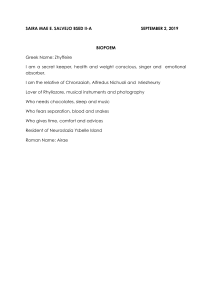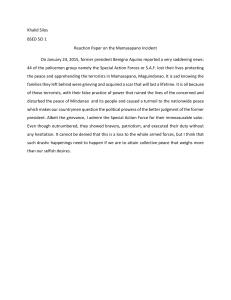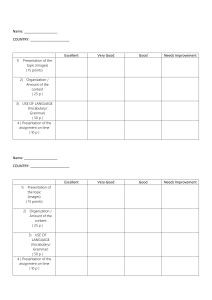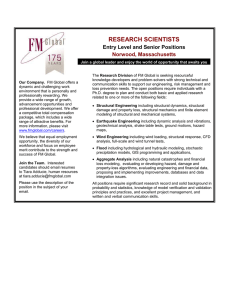Teaching English in Elementary Grades: Course Expectations
advertisement
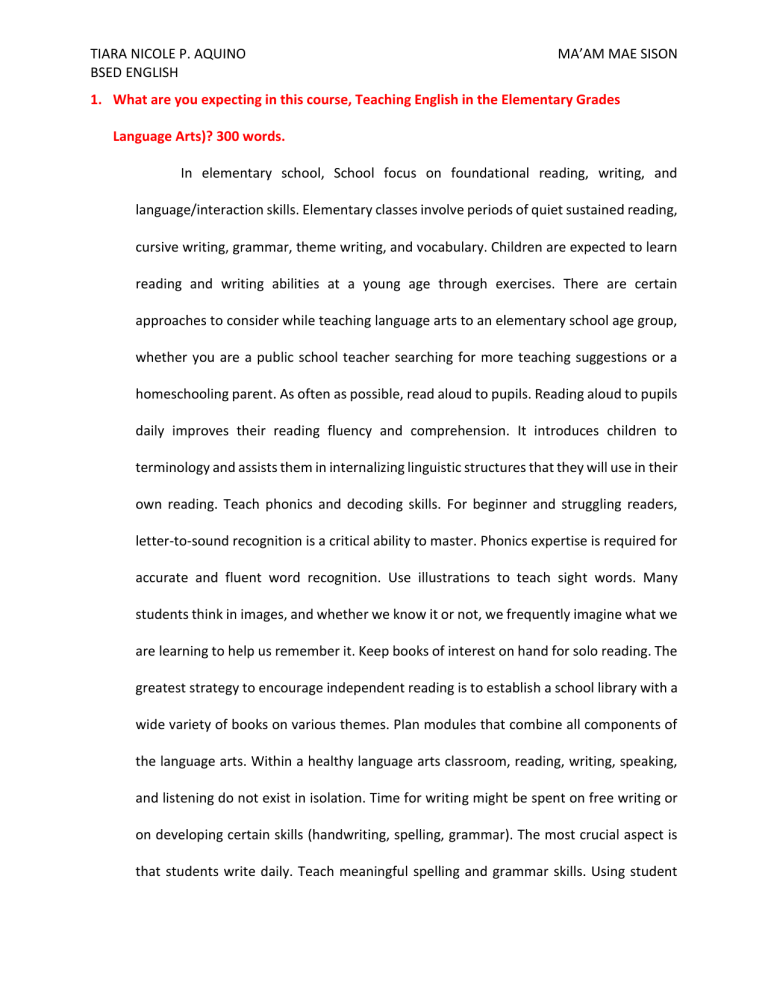
TIARA NICOLE P. AQUINO BSED ENGLISH MA’AM MAE SISON 1. What are you expecting in this course, Teaching English in the Elementary Grades Language Arts)? 300 words. In elementary school, School focus on foundational reading, writing, and language/interaction skills. Elementary classes involve periods of quiet sustained reading, cursive writing, grammar, theme writing, and vocabulary. Children are expected to learn reading and writing abilities at a young age through exercises. There are certain approaches to consider while teaching language arts to an elementary school age group, whether you are a public school teacher searching for more teaching suggestions or a homeschooling parent. As often as possible, read aloud to pupils. Reading aloud to pupils daily improves their reading fluency and comprehension. It introduces children to terminology and assists them in internalizing linguistic structures that they will use in their own reading. Teach phonics and decoding skills. For beginner and struggling readers, letter-to-sound recognition is a critical ability to master. Phonics expertise is required for accurate and fluent word recognition. Use illustrations to teach sight words. Many students think in images, and whether we know it or not, we frequently imagine what we are learning to help us remember it. Keep books of interest on hand for solo reading. The greatest strategy to encourage independent reading is to establish a school library with a wide variety of books on various themes. Plan modules that combine all components of the language arts. Within a healthy language arts classroom, reading, writing, speaking, and listening do not exist in isolation. Time for writing might be spent on free writing or on developing certain skills (handwriting, spelling, grammar). The most crucial aspect is that students write daily. Teach meaningful spelling and grammar skills. Using student TIARA NICOLE P. AQUINO BSED ENGLISH MA’AM MAE SISON work as examples is one of the most effective ways to teach spelling and grammar. Make a list of the most common errors you observe in students' writing when they turn it in. Lastly To cover all bases, try to use as many different teaching models as possible. To suit your students' diverse learning styles, use visuals, lectures, exercises, music, group projects, and so on. 2. What are the micro skills in English language? When we learn our native language, we usually learn to listen first, then to speak, then to read, and finally to write. These are called the four "language skills" or “micro skills” Listening Speaking Reading Writing 3.What are the methods of teaching in English? Based on my research there are 11 different teaching approaches and methodologies have been tried and tested with some being more popular and effective than others. The direct method of teaching English is also known as the Natural Method. It’s used to teach a number of different languages not just English, and the main idea of the Direct Method is that it only uses the target language that the students are trying to learn. Its main focus is oral skill and it is taught via repetitive drilling. Grammar is taught using an inductive way and students need to try and guess the rules through the teacher’s oral presentation. TIARA NICOLE P. AQUINO BSED ENGLISH MA’AM MAE SISON The Grammar Translation Method Just like its name suggests, this method of teaching English is grammar heavy and relies a lot on translation. This is the traditional or ‘classical’ way of learning a language and it’s still commonly used when learning some languages. The Audio Lingual Method otherwise known as the New Key Method or Army Method is based on a behavirourist theory that things are able to be learned by constant reinforcement. This is related to the Direct Method and just like its predecessor it only uses the target language. The biggest difference between the Audio Lingual Method and the Direct Method is its focus of teaching. The Direct Methods focuses on the teaching of vocabulary whereas the Audio Lingual Method focuses on specific grammar teachings. The Structural Approach. As the name suggests, the method is all about structure. The idea is that any language is made up of complex grammar rules. These rules, according to this approach need to be learnt in a specific order, for example the logical thing would be to teach the verb “to be” prior to teaching the present continuous which requires using the auxiliary form of the verb “to be.” Suggestopedia. This is a behaviourist theory and related to pseudoscience. This method relies heavily on students’ belief about the method’s effectiveness. This theory is intended to offer learners various choices, which in turn helps them become more responsible for their learning. TIARA NICOLE P. AQUINO BSED ENGLISH MA’AM MAE SISON Total Physical Response, otherwise known as TPR is an approach that follows the idea of ‘learning by doing’. Beginners will learn English through a series of repetitive actions such as “Stand up”, “Open your book”, “Close the door”, and “Walk to the window and open it.” Communicative Language Teaching (CLT) The idea behind this approach is to help learners communicate more effectively and correctly in realistic situations that they may find themselves in. This type of teaching involves focusing on important functions like suggesting, thanking, inviting, complaining, and asking for directions to name but a few. The Silent Way, The Silent Way emphasises learner autonomy. The teacher acts merely as a facilitator trying to encourage students to be more active in their learning. The main of this way of teaching is for the teacher to say very little, so students can take control of their learning. Community Language Learning, This is probably one of the English teaching methods where the student feels the safest as there’s a great emphasis on the relationship and bond between the student and teacher. Unlike a lot of the other methods and approaches of teaching English as a Second Language, a lot of the L1 (mother tongue) is used for translation purposes. Task Based Language Learning, The main aim of this approach to learning is task completion. Usually, relevant and interesting tasks are set by the teacher and students are expected to draw on their pre-existing knowledge of English to complete the task with as few errors as possible. TIARA NICOLE P. AQUINO BSED ENGLISH MA’AM MAE SISON Lastly The Lexical Approach, The Lexical syllabus or approach is based on computer studies that have previously identified the most commonly used words. This approach in teaching focuses on vocabulary acquisition and teaching lexical chunks in order of their frequency and use. Teachers of the Lexical Approach place a great emphasis on authentic materials and realistic scenarios for more valuable learning. http://www.huntesl.com/a-brief-look-at-the-different-esl-teaching-approaches-andmethods/ 4. What are the strategies and techniques use in languange skills? CULTIVATE RELATIONSHIPS AND BE CULTURALLY RESPONSIVE No surprise here. A successful classroom, our educators agreed, is one in which students feel known, appreciated, and comfortable taking emotional and intellectual risks. That requires intentional planning and consistent messaging by the teacher. TEACH LANGUAGE SKILLS ACROSS THE CURRICULUM English language learners should not be learning the fundamentals of English in isolation; they should be applying their developing language skills to rich academic content in all subjects. EMPHASIZE PRODUCTIVE LANGUAGE The educators I interviewed agreed that productive language skills—hard-tomaster dimensions of language fluency like speaking and writing—should be front and center from day one, even if students feel hesitant about them. TIARA NICOLE P. AQUINO BSED ENGLISH MA’AM MAE SISON SPEAK SLOWLY—AND INCREASE YOUR WAIT TIME Easier said than done. Still, many of the teachers I spoke to said this simple change is vital. You can record yourself speaking in class to measure your cadence, and adjust. DIFFERENTIATE—AND USE MULTIPLE MODALITIES All kids learn better when they engage with material in multiple ways: Lessons that involve writing, speaking, drawing, and listening, for example, give students four opportunities to deepen their understanding of the work. For ELLs, those additional engagements also provide a little breathing room so they can work through the language barrier. INCORPORATE STUDENTS’ NATIVE LANGUAGES—AND DON’T BE AFRAID OF TECHNOLOGY Bilingualism is the goal, of course, not replacement. https://www.edutopia.org/article/6-essential-strategies-teaching-englishlanguage-learners TIARA NICOLE P. AQUINO BSED ENGLISH MA’AM MAE SISON 5. What are the methods of assessing ESL students? Throughout the year, ESL students are continually acquiring new vocabulary, language skills, and cultural standards. As a result, it is critical to perform informal evaluations regularly, evaluating student changes over time. Here are some Assessment Strategies that often work well for ESL students. Performance Assessments, Standardized tests tend to rely on written skills rather than oral skills. Gamification, Gamification is an increasingly popular concept in today’s teaching. The concept of “gamification” refers to the use of game elements in non-gaming contexts, such as in the classroom. Portfolios, Students who are developing multiple languages can benefit from portfolio assessments that allow them to gather authentic evidence of understanding. Conferences, Conferences with students can provide them with opportunities to explain and share what they have learned. Conferencing also offers educators a chance to provide authentic, real-time feedback that addresses student questions. Rubrics, Whichever approaches to formal or informal assessment you choose, rubrics are an effective way to provide a consistent criterion for grading and feedback. https://degree.lamar.edu/articles/education/assessment-strategies-for-esl-learners/
